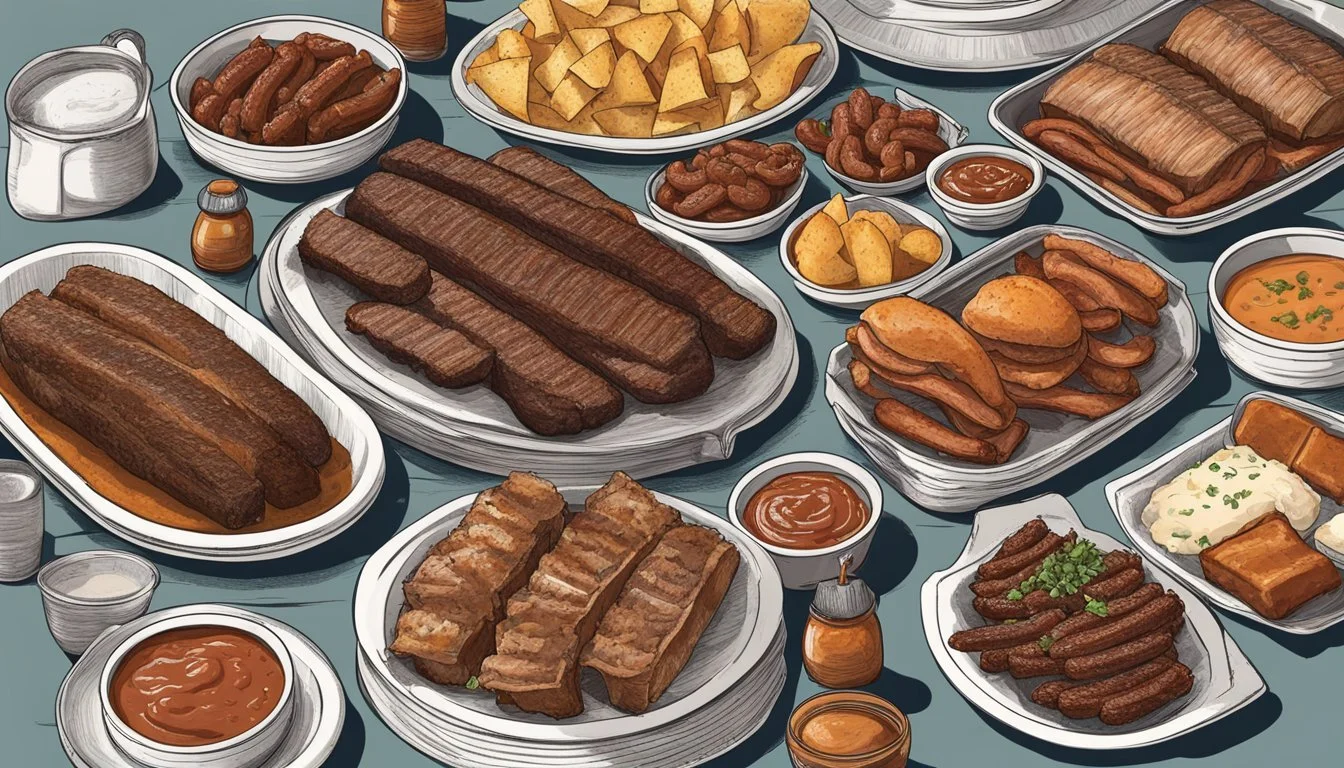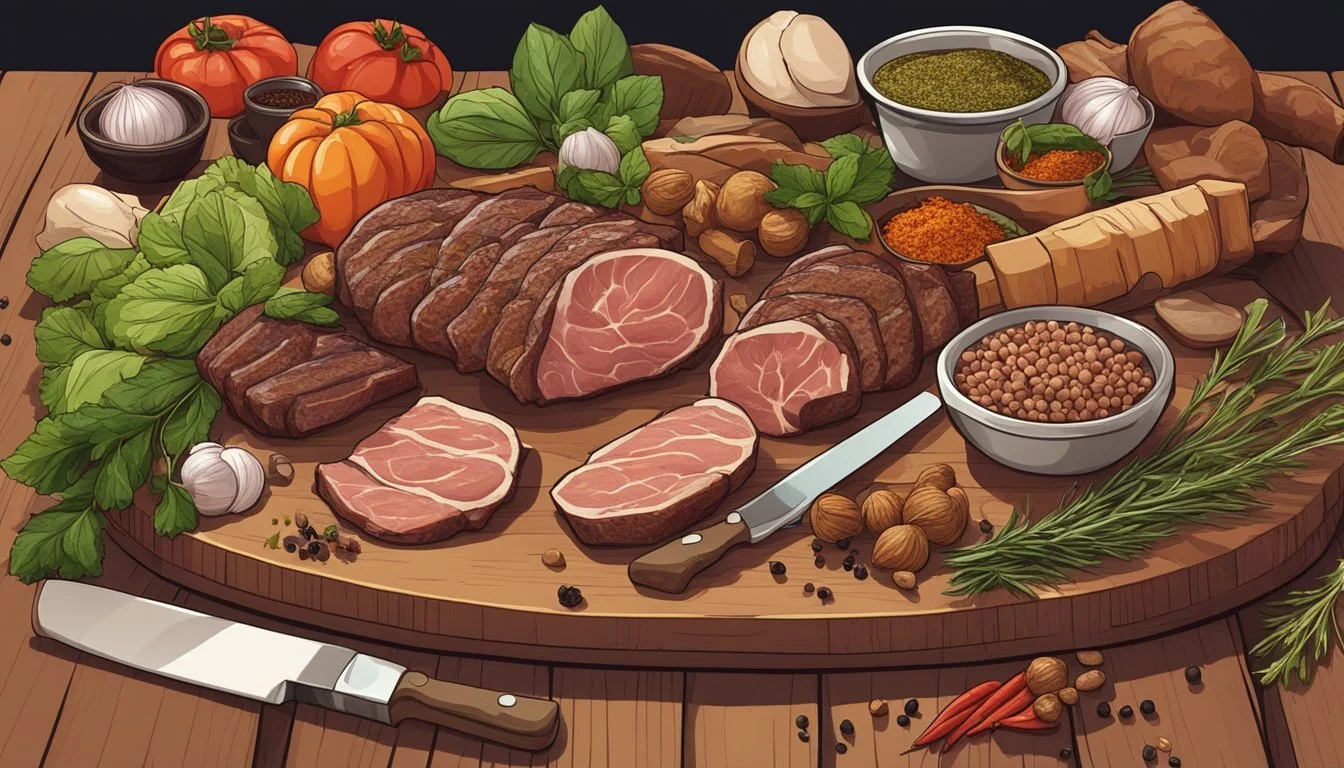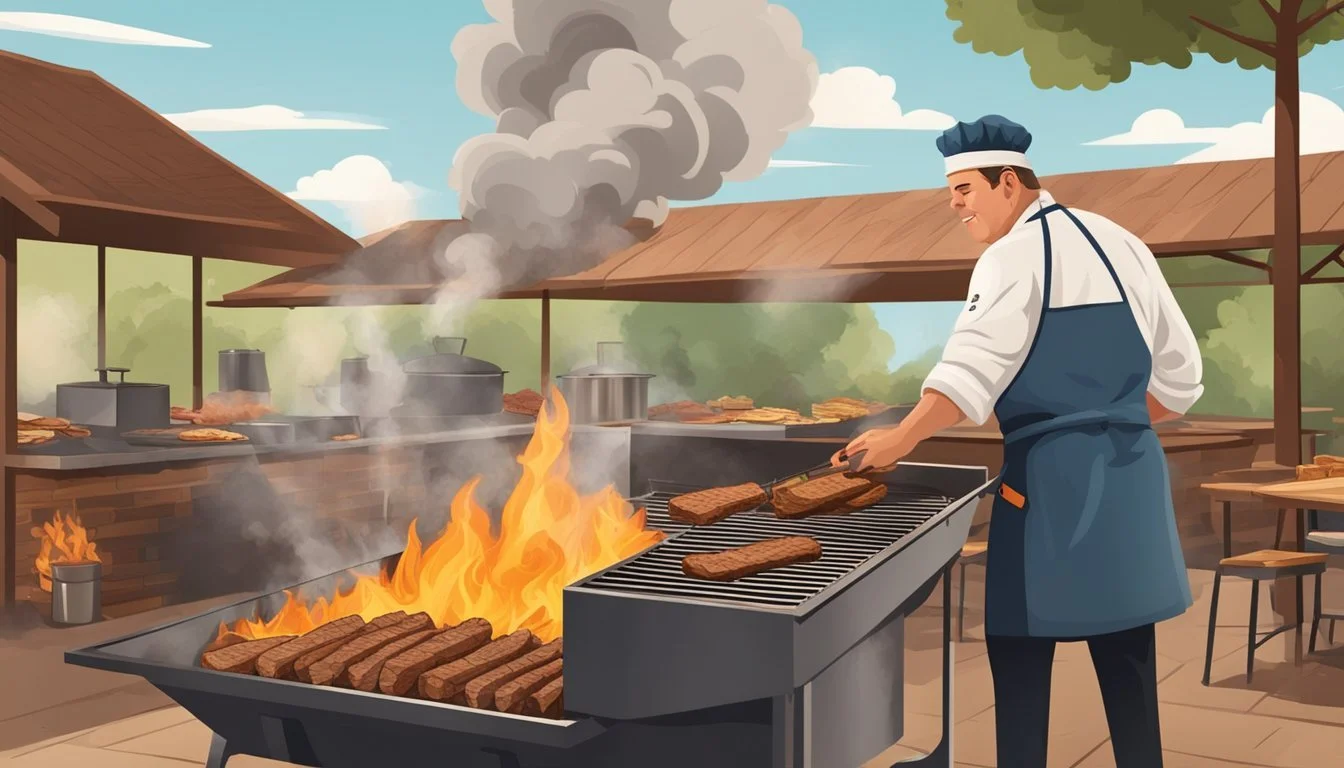The Great Texas Barbecue Debate
Exploring Regional Styles Across the Lone Star State
Texas is often celebrated for its distinctive contribution to American barbecue (What wine goes well with barbecue?), but within the state itself, a spirited debate simmers over which regional approach reigns supreme. With a landscape as large and diverse as the techniques used to perfect brisket, ribs, and sausages, the Lone Star State's barbecue is more than a culinary style; it's a cultural tapestry rich with history and tradition. From the hardwood smoke of Central Texas to the tangy sauces of East Texas, each region proudly touts its own version of barbecue excellence.
Understanding the nuances of Texas barbecue is essential for both connoisseurs and casual enthusiasts alike. The state's four main regions—East, Central, South, and West Texas—each claim a distinct style shaped by local cultures and histories. East Texas barbecue is known for its succulent, slow-cooked pork traditionally served with a sweet tomato-based sauce, while Central Texas boasts a dry rub approach that lets the smoked meat speak for itself, often foregoing sauce altogether.
Across the state, debates are as heated as the pits used to smoke the meats. Some argue that the smokiness of the beef brisket (What wine goes well with beef brisket?) defines Texas barbecue, while others point to the fall-off-the-bone tenderness of ribs as the true standard. The South and West Texas styles introduce their own flavors, from the influence of Mexican spices to the use of mesquite wood. Each style offers a sensory journey through the tastes and narratives that shape Texas barbecue, inviting both locals and visitors to partake in a time-honored culinary debate.
Origins of Texas Barbecue
Texas barbecue, an integral part of the Lone Star State's cuisine, evolved from a tapestry of culinary practices brought by immigrants and the influence of native traditions. German and Czech settlers in Central Texas introduced meat-smoking techniques in the 19th century, the foundation of what many now recognize as Texas barbecue. They initially used this method to preserve meat, a necessity before the advent of refrigeration.
Key Influences:
German and Czech Settlers: Smoking meats over wood
Mexican Traditions: Barbacoa, involving slow-cooking meats over a pit
Southern Cooking: Integration of sides like coleslaw and beans
Over time, these practices merged with Southern cooking styles and the Mexican tradition of barbacoa, creating a distinct Texas barbecue ethos. Barbacoa, which involved cooking meat, typically sheep or goat, over an open pit, influenced the cooking processes familiar in Texas barbecue.
The diverse regions of Texas have each contributed to the barbecue style's evolution. While Central Texas is known for its use of rubs and indirect heat smoking of meats like beef brisket, East Texas style typically includes a sweet tomato-based sauce, with the meat cooked directly over hickory wood. South Texas style often features more Mexican influences and employs molasses-like sauces, while the West Texas method, also known as "cowboy style," involves direct cooking over mesquite wood.
Regional Styles:
Central Texas: Dry rubs, indirect heat, beef brisket
East Texas: Sweet tomato-based sauce, direct hickory smoke
South Texas: Mexican influences, molasses-like sauces
West Texas: Direct cooking over mesquite ("cowboy style")
The landscape of Texas barbecue continues to evolve, but the crucial elements remain tied to the traditions and methods established by early settlers and the integration of those with local customs and ingredients.
Regional Variations
In Texas, barbecue is more than just a culinary tradition—it's a point of regional pride. Each area boasts its own take on BBQ, with variations in smoking methods, sauces, and meats. Here's how these differences pan out across the Lone Star State.
Central Texas Barbecue
Central Texas is renowned for its smoked brisket, a legacy of its German and Czech origins. This style typically involves smoking meats, especially brisket, over oak, particularly post oak, for several hours. The emphasis is on the quality of the smoke and meat, often eschewing sauces altogether or offering them on the side. Notable barbecue joints like Austin's Franklin Barbecue and Southside Market in Bastrop are bastions of this tradition.
East Texas Barbecue
The East Texas style, prevalent in areas around Houston, specializes in slow-cooked ribs, pulled pork, and chicken until the meat becomes tender enough to fall off the bone. Here, mesquite wood is often used in the smoking process, infusing a distinct flavor. The meats are served with sweet, tomato-based sauces, (What wine goes well with tomato-based sauces?) with smoked chicken being a regional highlight.
South Texas Barbacoa
Moving to South Texas, one finds barbacoa as the star. This style has Mexican influences and often involves cooking the whole head of a cow. Traditional methods include smoking meat with mesquite or pecan wood or cooking it in a pit with agave leaves. The result is juicy and tender, typically served with fresh tortillas.
West Texas Cowboy Style
West Texas BBQ, or "cowboy style," involves cooking meats directly over an open flame or using direct heat, rather than the smoking methods seen elsewhere. This technique creates a charred exterior while keeping the interior moist. Meats like beef and pork are commonly seen at community gatherings, reflecting the region's ranching heritage and rugged spirit.
Meat Selection and Preparation
In Texas barbecue, the choice and treatment of meats are pivotal, with specific cuts and preparations forming the identity of regional styles. Attention to detail in marinating and rub application plays a significant role in the flavor profile and texture of the barbecue.
Beef Brisket
Texas is synonymous with brisket, a cut that when smoked low and slow, transforms from a tough muscle into a tender delicacy. It's seasoned predominantly with a simple, yet robust mix of salt and black pepper, allowing the natural flavor of the meat to shine through. Central Texas style particularly favors this straightforward approach to smoked brisket.
Ribs and Sausages
Ribs in Texas are prepared with a rich layering of flavors, often incorporating both dry rubs and marinades. A variety of ribs are popular, including both pork and beef ribs. Sausage-making is an art in Texas, where links are crafted with a combination of meats and spices before being smoked to perfection.
Pulled Pork and Chicken
While pulled pork is more closely associated with South Texas, it holds its own throughout the state, with the meat being cooked until it can be "pulled" apart. Smoked chicken, on the other hand, is a lighter option often found on Texas barbecue menus, where it's infused with a subtle smokiness and typically seasoned with a blend of spices that can include paprika, garlic powder, and more.
Unique Offerings
Beyond the mainstream favorites, Texas BBQ includes specials like barbacoa, traditionally made with beef cheeks, and boudin, a type of sausage consisting of pork rice dressing. Some regions, such as South Texas, might even offer smoked whole goats at community events or festivals.
Marinades and Dry Rubs
A distinct selection of marinades and dry rubs contribute to the Texas barbecue's unique flair. They range from complex spicy concoctions to simple rubs focusing on salt and black pepper as their main ingredients. These preparations not only tenderize tougher cuts but also create a bark on the exterior of the meat, a beloved feature of Texas BBQ.
Cooking Techniques
The essence of Texas barbecue hinges on a deep understanding of cooking techniques. The delicate dance of heat and smoke over time imparts the unmistakable flavor that has put Texas BBQ on the map.
Wood and Smoke Flavors
The choice of wood is pivotal in Texas barbecue, as it influences the smoke that tenderizes and flavors the meat. Here is a breakdown of common woods used:
Oak: A traditional favorite, providing a medium smoky flavor.
Hickory: Offers a stronger taste and is often used for pork and ribs.
Mesquite: Intense and earthy, used sparingly due to its potency.
Pecan: Milder than hickory, with a sweet finish.
These woods are used either as logs, chips, or pellets to achieve the desired flavor profile.
Pitmaster Craft
Every Texas pitmaster brings years of experience and personal touch to the preparation of barbecue. Pitmasters utilize indirect heat from smoldering wood, meticulously managing the temperature and smoke levels. The art of smoking involves:
Temperature Control: Maintaining consistent low temperatures for many hours.
Smoke Management: Regulating smoke flow to ensure it envelops the meat without overwhelming it.
This intense involvement in the cooking process characterizes the dedication of Texas pitmasters.
Grilling vs. Smoking
While both grilling and smoking are techniques used in BBQ, they serve different purposes and yield distinct results:
Utilizes direct heat, with meat placed over open flame.
Suited for quick cooking at high temperatures.
Smoking:
Involves indirect heat, where meat is cooked slowly by smoky heat.
Embraced for tougher cuts that benefit from long, low-temperature exposure.
Texas barbecue, known for its emphasis on smoking, is often distinguished by this slow-cooked tenderness and depth of flavor.
Sides and Accompaniments
The Texas barbecue tradition extends beyond the smoked meats (What wine goes well with smoked meats?) to an array of sides and accompaniments that complement the flavors of the barbecue. These dishes add an essential layer to the experience, with something to suit every palate.
Traditional Sides
In Texas barbecue, traditional sides are just as important as the brisket or ribs they accompany. They often include:
Beans: A staple of Texan cuisine, usually prepared as pinto beans simmered with spices and sometimes bits of brisket.
Slaw: There are two main types—coleslaw which is generally creamy and tangy, and a vinegar-based slaw that provides a sharp contrast to rich meats.
Potato Salad: Usually a mustard-based salad with a creamy texture and a balance of sweet and tangy flavors.
Collard Greens: Slow-cooked with smoked meats, these greens are savory with a hint of bitterness.
Banana Pudding: A favored dessert, featuring layers of vanilla wafers, pudding, and bananas, often topped with whipped cream or meringue.
Breads and Tortillas
Breads and tortillas act as utensils as much as they serve as sides:
White Bread: Plain slices of white bread are traditional for sopping up meat juices and sauce.
Tortillas: Fresh tortillas are another common accompaniment, serving as a wrap or a base for tacos filled with chopped barbecue.
Condiments and Extras
To personalize the flavors further, an array of condiments and extras are offered on the side:
Pickles: Offered for their tangy crunch, they provide a refreshing balance to the smoky flavors.
BBQ Sauce: It can range from sweet to tangy to spicy, and each barbecue joint has its unique recipe.
Salsas: Fresh salsas add a burst of brightness and heat.
Chili: Rather than the main dish, chili is often a side to complement the main barbecue.
Guacamole: Rich and creamy, guacamole adds a cool, fresh contrast to the meal.
Mac and Cheese: A rich and creamy comfort dish commonly infused with sharp cheddar and baked to golden perfection.
These sides and accompaniments are customary, rounding out the experience of a Texas barbecue feast, and ensuring an array of textures and flavors on every plate.
Barbecue Culture
The Texas barbecue scene is an integral part of the state's identity, manifesting through a myriad of experiences from local eateries to large-scale events, and is subject to avid critique and comparison.
Barbecue Joints and Dining
In Texas, barbecue restaurants are more than just eateries; they are cultural landmarks. Places like Lockhart, often referred to as the "Barbecue Capital of Texas," feature historic joints like Kreuz Market, drawing visitors from all over the state and beyond. Dallas, Houston, San Antonio, Austin, and even El Paso boast a plethora of barbecue spots ranging from the traditional smokehouses to modern fusion establishments. Each city's barbecue reflects its local traditions and immigrant influences, making Texas BBQ a central aspect of Texas cuisine.
Austin: Renowned for innovative barbecue served in both rustic and sophisticated settings.
Dallas: Offers a high-end barbecue dining experience with a touch of Texan authenticity.
San Antonio: Blends traditional Mexican flavors with classic Texas barbecue.
Houston: A melting pot of barbecue influences, reflecting its diverse population.
El Paso: Infuses border flavors into its barbecue offerings.
Festivals and Competitions
Year-round, Texas celebrates its barbecue heritage with numerous festivals and competitions. Events like the Houston Livestock Show and Rodeo and the Austin BBQ Festival showcase the state's top pitmasters and their culinary prowess. These festivals not only feature live cooking demonstrations but also serve as battlegrounds where styles from Central Texas, East Texas, and beyond are pitted against each other.
Media and Criticism
Texas Monthly boasts a dedicated barbecue editor, reflecting the importance of this cuisine in media. Daniel Vaughn, the first barbecue editor, plays a pivotal role in critiquing and celebrating Texas barbecue through the magazine. Other media outlets like Thrillist and various travel guides often feature Texas barbecue, contributing to its nationwide recognition and influencing travelers' culinary itineraries.
Influence and Comparisons
Texas barbecue has impacted not only local food culture but also has established a significant presence nationally. It's often compared to other styles from regions like Memphis, North Carolina, and Alabama. Each style is distinct – with Texas BBQ well-recognized for its focus on beef brisket – but the Lone Star State's influence is evident in the spread of Texas-style barbecue restaurants across the country.
Future of Barbecue
As the Texas barbecue scene continues to grow and evolve, enthusiasts can anticipate three major areas of development: cutting-edge cooking methods and flavor profiles, distinct regional shifts, and an increased focus on health and sustainability.
Innovation in Techniques and Flavors
Barbecue chefs across Texas are experimenting with new smoking techniques and infusing bold flavors into classic dishes. One might find Mesquite-smoked brisket complemented with house-made salsas that showcase a blend of local and international ingredients. Cooks are also expanding their use of spices, creating unique rubs that push the boundaries of traditional Central Texas barbecue.
Regional Evolutions
Each region in Texas has its own barbecue identity: Central Texas is known for its focus on the quality of smoke and meat rather than heavy sauces, while East Texas barbecue often involves more marbled cuts that are slow-cooked to perfection. Moving forward, one can expect West Texas to bring its cowboy-style cooking with direct-heat methods to the forefront, and for South Texas to continue to showcase its Mexican-influenced barbacoa with well-seasoned sides.
Health and Sustainable Practices
The barbecue industry is becoming increasingly aware of health concerns and environmental impact. There's a growing trend towards leaner cuts of meat, and incorporation of more vegetable-centric sides on menus. Similarly, sustainable practices like sourcing meats locally and using environmentally-friendly smoking methods are becoming standard. Texas barbecue joints may increasingly highlight these practices, connecting conscientious consumers with the storied tradition of Texas barbecue.





